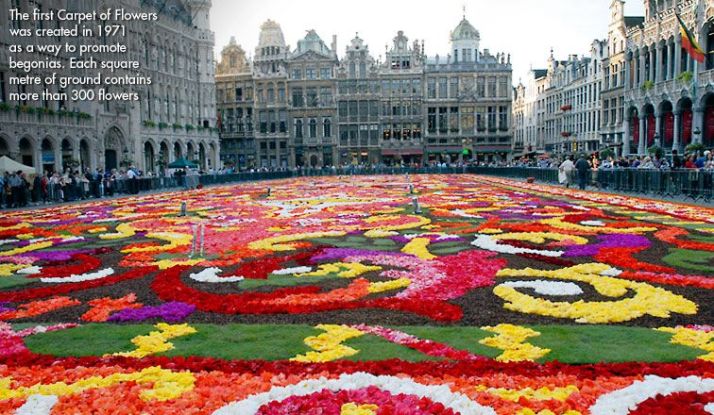Every two years for the past 40 years, the city of Brussels has drawn in a veritable collection of artisans, architects, designers, urban planners and home-furnishing enthusiasts to create and celebrate the unveiling of enormous carpets hand-crafted entirely from grassy turf and multicoloured begonia blooms. Having begun in 1971, this large-scale ephemeral floral art continues into modern days with elaborate designs ranging from medieval to art-nouveau styles. At Grand-Place in Brussels, this begonia carpet extravaganza was assembled by nearly 120 volunteers with close to one million begonias in merely four hours.
The next Flower Carpet Biennial is only four months away on 15 August 2012. Prepare to be dazzled again by one of the greatest begonia shows on Earth!
Excerpts from Brussels' Flower Carpet
The Begonias
The beauty and diversity of all these Carpets is largely due to their main component, the famous begonia. Chosen above all for its qualities of robustness, resistance to bad weather and strong sunshine the begonia guarantees the long life and freshness of the carpet. It also gives it is rich range of colours – from vivid colours to delicate pastel shades, with in between, the parti-coloured and white flowers which reflect the light so well.
This flower, the ideal ornament, which is already traditionally used in pageants and floral corsages, is also much loved by householders who use them to brighten their balconies and windowsills and embellish their flowerbeds. 80% of the total production of begonias, a native of the West Indies, cultivated almost exclusively in the Ghent area since 1860, is exported. Belgium cultivates 60 million begonia tubers every year, and is recognised as the world’s largest producer. The Netherlands, France and the United States are its best customers.
History
Officially, the first Floral Carpet as its present-day form was created in 1971 on the Grand-Place by the landscape architect E. Stautemans, but, in fact, it was the culmination of a whole series created in various towns in Flanders.
E. Stautemans, who was born in Zottegem, and graduated from the Ghent Horticultural College, had been experimenting since the early 1950s making simple small carpets, more like rugs, mainly consisting of begonias (in Knokke, Oudenaarde, Sint-Niklaas, Lille…).
He very quickly realised that floral carpets would be an excellent vehicle for the promotion of his beloved begonias which he had always worked with, both technically, economically and aesthetically.
After years of attempts and calculations, this architect, who was inventive and imaginative, and knew how to make the most of the numerous resources of begonias, became an expert in the creation of superb floral carpets with sophisticated colours and complicated designs.
His fame spread and he was asked to make carpets not only in Belgium (Ghent, Bruges, Antwerp, Ypres, Courtrai, Hasselt, Tongres, Mons, Durbuy, …) but worldwide (Cologne, Hamburg, Luxemburg, Paris, London, Breda, Amsterdam, The Hague, Vienna, Valencia, and as far afield as Buenos Aires and Colombus, Ohio).
Some of these carpets were bigger than the ones created in Brussels (77 x 24 m), like the 1973 masterpiece at Sint-Pietersplein, Ghent that reached a gigantic 164 x 42 m.
However, as E. Stautemas himself says, “Nowhere is the carpet more beautiful and distinguished than in the unique, ancient surroundings of the Grand-Place in Brussels”.
Making a Carpet
The actual making of the Carpet is based on a plan worked out in advance, consisting of several stages.
Everything starts, often a year in advance, with projects and scale models, illustrating a commissioned theme (such as the commemoration of great events, or the arms and shield of a town, and sometimes the proposals of local horticultural associations).
Once the theme has been produced in representation and symbol, the number of flowers and colour combinations calculated and the outlines finally drawn on the ground, then the work starts. The skilful, dedicated work of a hundred experienced gardeners and their enthusiasm enables them to put together this giant floral jigsaw in under four hours.
The day before, the spaces between the floral patterns will already have been filled with rolled turf. Did you know – that the flowers are packed together one by one, 300 to every square meter of the ground, (+/- 750,000 flowers!) so tightly (no soil is used at all) that they won’t be blown away by the first puff of wind, and create their own microclimate? In heat waves, the turf has to be watered to prevent it from shrinking, but if the weather is too wet, the grass can grow 4 to 5 centimeters in 3 days? The wonders of nature!



Pingback: Interior Style Trends 2012 – Katie Ridder on Design Lemonade! | Re-Do it Design
Pingback: Interior Style Trends 2012 – Katie Ridder on Design Lemonade! | Redo it Design
Pingback: 2012 in Review – Queensland Begonia Society’s Annual Report with Season Greetings, Statistics, City Skyline, Mountains, Spotlights and Fireworks! | Queensland Begonia Society